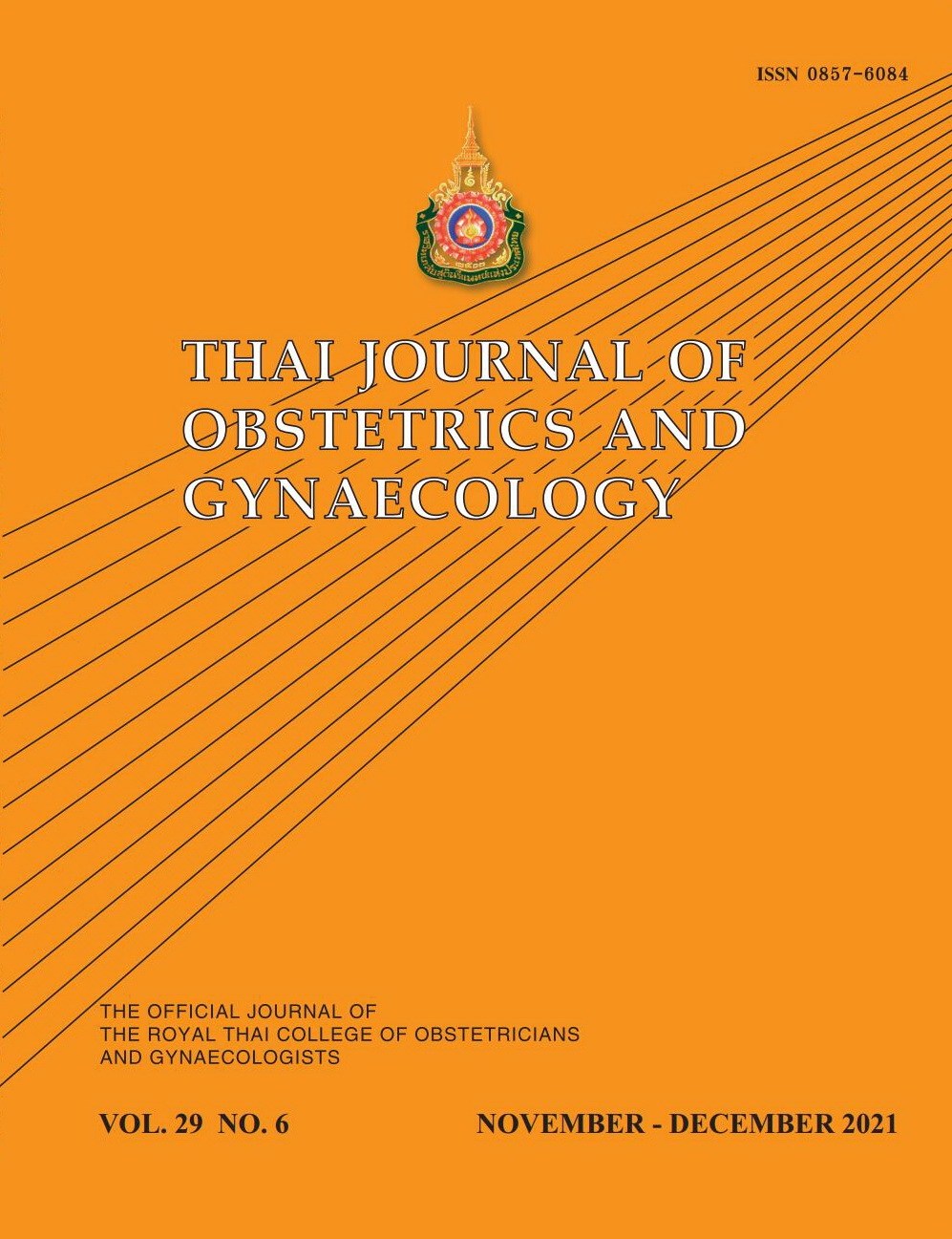Accuracy of Intrapartum Fetal Weight Estimation Using Dare’s Formula and Transabdominal Ultrasonography in Pregnant Women with Normal and High Prepregnant BMI at Maharat Nakhon Ratchasima Hospital
Main Article Content
Abstract
Objective : To compare the accuracy of clinical fetal weight estimation using Dare’s formula and sonographic estimation using Hadlock’s formula in pregnant women with normal and high prepregnant BMI.
Materials and Methods : This prospective cohort study was conducted in at Maharat Nakhon Ratchasima Hospital in Thailand between July 2019 to November 2019. Term singleton pregnant women whose prepregnant BMI was 18.5 or greater were included. Maternal BMI was divided into normal BMI (18.5 – 23.0) and high BMI (≥ 23.0) for Asian population. Symphysis-fundal height and abdominal circumference was measured, followed by performing sonographic estimation using Hadlock’s formula by second-year residents. The primary outcome was the accuracy rate defined by the absolute percentage error of estimated fetal weight < 10 percent.
Results : 205 pregnant women were recruited. Overall accuracy of clinical estimation and sonographic estimation was 52.7% and 80.0% (p<0.001). In normal BMI group, the accuracy was similar between two methods (p=0.143). In high BMI group, sonographic estimation was more accurate than clinical estimation (77.8% vs. 36.8%, p<0.001).
Conclusion : Sonographic estimation can be used to estimate fetal weight in pregnant women with normal and high prepregnant BMI group with acceptable accuracy. However, clinical estimation may reliably substitute sonographic estimation among pregnant women with normal BMI group in the condition that transabdominal ultrasonography is not accessible.
Article Details
References
2. Ng M, Fleming T, Robinson M, Thomson B, Graetz N, Margono C, et al. Global, regional, and national prevalence of overweight and obesity in children and adults during 1980-2013: a systematic analysis for the Global Burden of Disease Study 2013. Lancet. 2014;384(9945):766-81.
3. Collaborators GBDO, Afshin A, Forouzanfar MH, Reitsma MB, Sur P, Estep K, et al. Health Effects of Overweight and Obesity in 195 Countries over 25 Years. N Engl J Med. 2017;377(1):13-27.
4. Heslehurst N, Ells LJ, Simpson H, Batterham A, Wilkinson J, Summerbell CD. Trends in maternal obesity incidence rates, demographic predictors, and health inequalities in 36,821 women over a 15-year period. BJOG. 2007;114(2):187-94.
5. Mission JF, Marshall NE, Caughey AB. Obesity in pregnancy: a big problem and getting bigger. Obstet Gynecol Surv. 2013;68(5):389-99.
6. Scott-Pillai R, Spence D, Cardwell CR, Hunter A, Holmes VA. The impact of body mass index on maternal and neonatal outcomes: a retrospective study in a UK obstetric population, 2004-2011. BJOG. 2013;120(8):932-9.
7. American College of Obstetricians and Gynecologists. ACOG Practice bulletin No. 156: Obesity in Pregnancy. Obstet Gynecol. 2015;126(6):e112-26.
8. Farrell T, Holmes R, Stone P. The effect of body mass index on three methods of fetal weight estimation. BJOG. 2002;109(6):651-7.
9. Field NT, Piper JM, Langer O. The effect of maternal obesity on the accuracy of fetal weight estimation. Obstet Gynecol. 1995;86(1):102-7.
10. Fox NS, Bhavsar V, Saltzman DH, Rebarber A, Chasen ST. Influence of maternal body mass index on the clinical estimation of fetal weight in term pregnancies. Obstet Gynecol. 2009;113(3):641-5.
11. Aksoy H, Aksoy U, Karadag OI, Yucel B, Aydin T, Babayigit MA. Influence of maternal body mass index on sonographic fetal weight estimation prior to scheduled delivery. J Obstet Gynaecol Res. 2015;41(10):1556-61.
12. Kritzer S, Magner K, Warshak CR. Increasing maternal body mass index and the accuracy of sonographic estimation of fetal weight near delivery. J Ultrasound Med. 2014;33(12):2173-9.
13. Kumari A, Goswami S, Mukherjee P. Comparative Study of Various Methods of Fetal Weight Estimation in Term Pregnancy. J South Asian Feder Obst Gynae. 2013;5(1):22-5.
14. Raghuvanshi T, Pawar M, Patil A. Comparative Study of Foetal Weight Estimation by Various Methods among Term Pregnancies at Rural Tertiary Care Centre, Maharashtra. Journal of Evoluation of Medical and Dental Sciences. 2014;3(41):10291-6.
15. Heer IM, Kumper C, Vogtle N, Muller-Egloff S, Dugas M, Strauss A. Analysis of factors influencing the ultrasonic fetal weight estimation. Fetal Diagn Ther. 2008;23(3):204-10.
16. American College of Obstetricians and Gynecologists. ACOG Practice bulletin No. 134: fetal growth restriction. Obstet Gynecol. 2013;121(5):1122-33.
17. American College of Obstetricians and Gynecologists. ACOG Practice bulletin No. 173: Fetal Macrosomia. Obstet Gynecol. 2016;128(5):e195-e209.
18. WHO Expert Consultation. Appropriate body-mass index for Asian populations and its implications for policy and intervention strategies. Lancet 2004;363:157-63.


